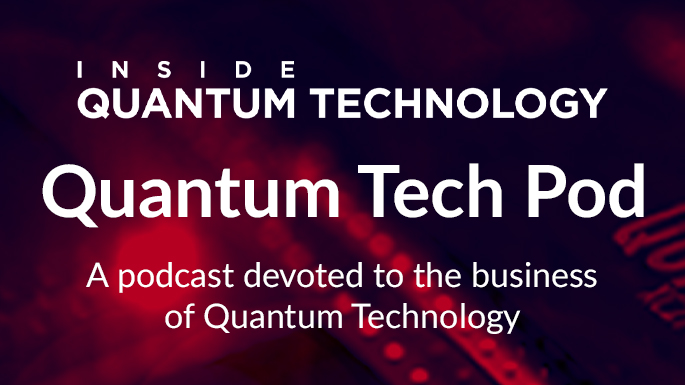Quantum News Briefs October 18: Quantum Computing, Inc. Receives Award to Support NASA in Quantum Sensing Solutions for LiDAR Missions • Cyber Officials Cite Legacy Systems as Post-Quantum Readiness Challenge • Taiwanese Researchers Unveil World’s Smallest Single-Photon Quantum Computer • UNM Engineering Professor Part of $7.5M DOE Quantum Computing Research • World Economic Forum: AI, Quantum Require ‘Paradigm Shift’ in Security

Quantum Computing, Inc. Receives Award to Support NASA in Quantum Sensing Solutions for LiDAR Missions
 Quantum Computing Inc. (“QCi” or the “Company”), an innovative, integrated photonics and quantum optics technology company, announced on October 17 that the Company has been awarded a fifth project from the National Aeronautics and Space Administration (NASA) to develop quantum remote sensing technology that would significantly lower the cost of spaceborne LIDAR imaging and advance scientific understanding of the mechanisms of climate change.
Quantum Computing Inc. (“QCi” or the “Company”), an innovative, integrated photonics and quantum optics technology company, announced on October 17 that the Company has been awarded a fifth project from the National Aeronautics and Space Administration (NASA) to develop quantum remote sensing technology that would significantly lower the cost of spaceborne LIDAR imaging and advance scientific understanding of the mechanisms of climate change.
This is a continuation of a long-standing strategic partnership between NASA and QCi aimed at creating a radically different approach to LiDAR technology for atmospheric remote sensing measurements. The proposed approach, which is currently being developed by QCi, would significantly lower the cost of LIDAR missions, thereby allowing NASA to undertake more frequent flights to better understand the causes of climate change. The recently awarded contract is an important milestone in further assessing viability of QCi’s technology.
The new contract also marks a pivotal step toward deploying the Company’s remote sensing technology on LIDAR flights and further establishes the applicability of its quantum technology in diverse fields, such as civilian and military surveillance.
In Other News: FedScoop Reports “Cyber Officials Cite Legacy Systems as Post-Quantum Readiness Challenge”
>The survey also found 29% respondents said operational technology systems were a “complicating factor.” And lack of planning, guidance and strategy were also an issue for implementation according to 37% of respondents, the survey found.
These results were about two months after the first post-quantum cryptography standards were finalized by the National Institute of Standards and Technology, The survey results paint a picture of federal agencies just beginning to create strategies and identifying barriers in those efforts.
Taiwanese Researchers Unveil World’s Smallest Single-Photon Quantum Computer
 Researchers in Taiwan have claimed to have created the smallest single-photon quantum computer in the world as reported by Jijo Malayil in October 17 Interesting Engineering.
Researchers in Taiwan have claimed to have created the smallest single-photon quantum computer in the world as reported by Jijo Malayil in October 17 Interesting Engineering.
At a press briefing, a group from National Tsing Hua University (NTHU) showcased their inventiveness. They demonstrated the use of “Shor’s algorithm” to solve prime factorization on their box-sized quantum computer.
A single high-dimensional photon, a fundamental particle involved in electromagnetic interactions, has a wave packet that contains “32 time-bins or dimensions” of information that can be encoded by the researchers’ incredibly small quantum computer.
photons offer a major advantage in the development of commercial quantum computers due to their extended transmission range and reduced susceptibility to interference.
The device uses calcium ion-based optical qubits, in which entanglement is produced by laser pulses that change the ions’ states.
Macroscopic electric-field traps that regulate up to 50 ions operate the processor. Its modular architecture consists of parts for remote communication, ion trapping, and laser control, all kept in aluminum boxes inside the racks.
Photons also provide substantial benefits for business applications by enabling long-distance information transfer with little interference.
During a press briefing, the NTHU team emphasized that its tiny photon-based quantum gadget functions without the need for massive cooling systems, in contrast to many quantum computers in leading research labs.
This discovery, according to researchers, represents a major breakthrough in the realm of quantum technologies.
UNM Engineering Professor Part of $7.5M DOE Quantum Computing Research
 Milad Marvian, an assistant professor in the University of New Mexico School of Engineering, is part of a $7.5 million Department of Energy (DOE) project to research quantum algorithm theory and advance the study of quantum computing as per the October 17 news release.
Milad Marvian, an assistant professor in the University of New Mexico School of Engineering, is part of a $7.5 million Department of Energy (DOE) project to research quantum algorithm theory and advance the study of quantum computing as per the October 17 news release.
“Our goal is to develop novel mathematical tools that can enrich our understanding of the power and limitations of quantum computation, and provide fresh insights into the design of new quantum algorithms,” Marvian said.
A faculty member in the Department of Electrical and Computer Engineering and a member of Quantum New Mexico Institute, Marvian will work on the quantum research project titled, “FAR-Qu: Fundamental Algorithmic Research towards Quantum Utility.” The project is led by Sandia National Laboratories in partnership with UNM, Caltech, University of Maryland, Los Alamos National Laboratory, Argonne National Laboratory, Lawrence Berkeley National Laboratory, and Oak Ridge National Laboratory.
The project is part of a $65 million DOE investment across 10 projects focused on quantum computing research targeting software, control systems and algorithmic advancements. The funding is part of a larger federal initiative to accelerate quantum research in the U.S.
The newly established Quantum New Mexico Institute is a center for interdisciplinary research in quantum information science. QNM-I researchers work in a number of different academic areas across campus including Physics and Astronomy, Electrical and Computer Engineering, Chemistry and Chemical Biology.
In Other News: World Economic Forum Writes: “World Economic Forum: AI, Quantum Require ‘Paradigm Shift’ in Security”
 The World Economic Forum (WEF) points out in October 17 report by Jeffrey Burt that more than 200 such emerging and critical technologies, which include the likes of biotechnology, blockchain, autonomous systems, and cryptocurrency, are increasing cybersecurity risks by creating new vulnerabilities and complexities that traditional protections can’t address.
The World Economic Forum (WEF) points out in October 17 report by Jeffrey Burt that more than 200 such emerging and critical technologies, which include the likes of biotechnology, blockchain, autonomous systems, and cryptocurrency, are increasing cybersecurity risks by creating new vulnerabilities and complexities that traditional protections can’t address.
The report stipulates that what is needed as these technologies develop is a move away from the current “security by design” efforts – a mindset advocated by CISA and other U.S. and international government security agencies and most tech companies that calls for embedding security features into technologies from the start – to “resilience by design,” which the WEF said goes further to ensure that systems can withstand and recover from attacks that will inevitably occur as the technologies mature and proliferate.
“The increasing interconnectivity of these technologies results in a more complex and dynamic threat landscape,” the organization wrote in its report, “Navigating Cyber Resilience in the Age of Emerging Technologies.” “A breach in one system can trigger cascading effects across multiple interconnected networks, potentially disrupting critical infrastructure and services on a massive scale. . .”
The promises to get more challenging, the report’s authors wrote, noting that by 2030, there is projected to be 32 billion connected devices, with each one representing a potential vulnerability that will require strong security and comprehensive monitoring.


















